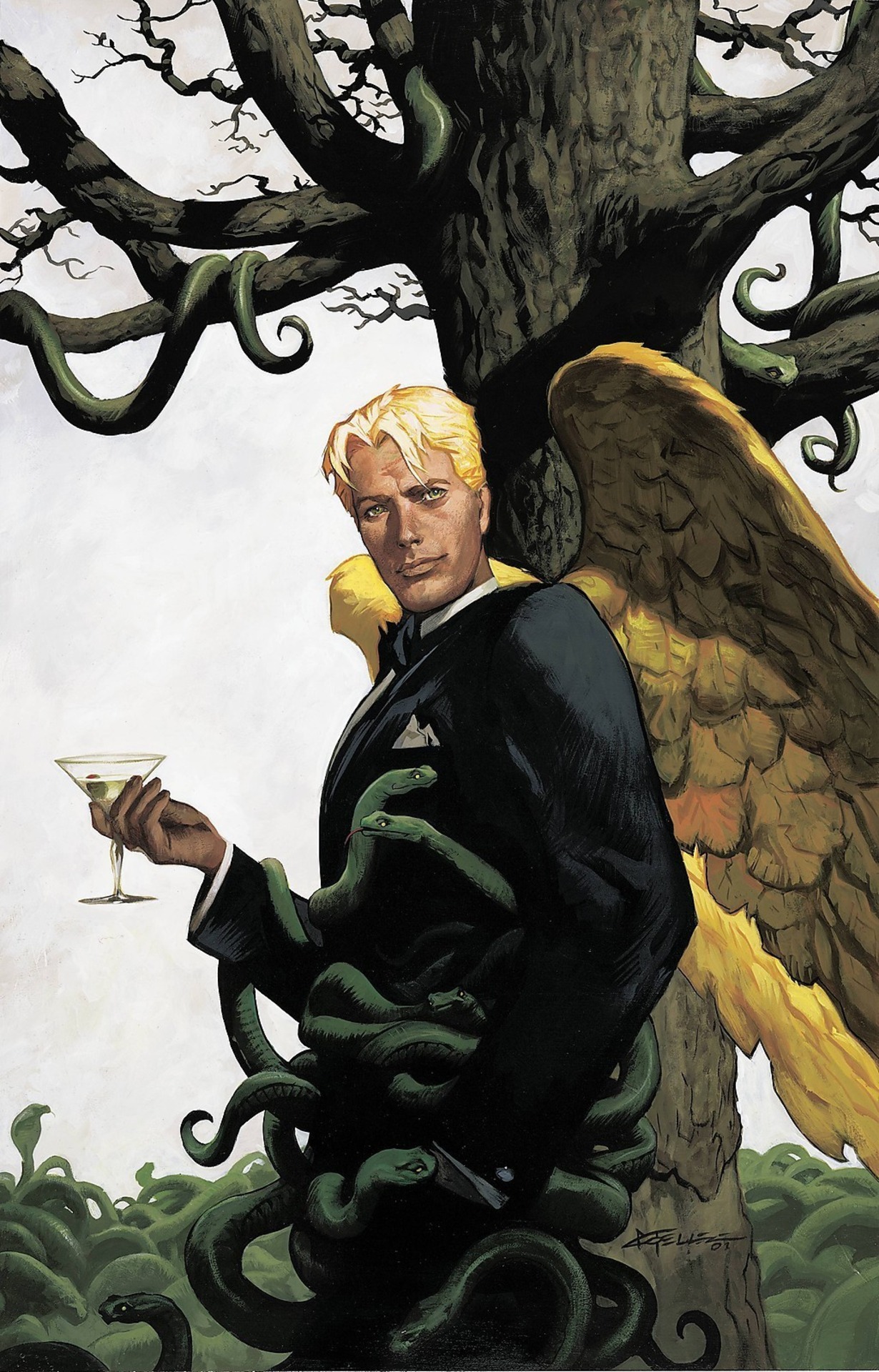Post by DSkillz on Jan 12, 2015 23:56:00 GMT

Lucifer Morningstar (DC Comics)
Lucifer Morningstar is a DC Comics character appearing primarily as a supporting character in the comic book series The Sandman and as the title character of a spin-off, both published under the Vertigo imprint.
Though various depictions of Lucifer – the Biblical fallen angel and Devil of the Abrahamic religions – have been presented by DC Comics in their run, this interpretation by Neil Gaiman debuted in The Sandman in 1989. Like many modern interpretations of Satan, DC's Lucifer owes much to the character's portrayal in John Milton's epic poem Paradise Lost, though Gaiman adapts the character to fit the fictional DC Universe where their comics are set, where the character exists alongside superheroes and deities from multiple religions.
Later, the character acquired an ongoing Lucifer spin-off series written by Mike Carey, depicting his adventures on Earth, Heaven, and in the various other realms of his family's creations and in uncreated voids after abandoning Hell in the Sandman series. Lucifer also appears as a supporting character in issues of The Demon, The Spectre, and other DC Universe comics. Two angels, several demons, a human, and briefly Superman have taken his place as ruler of Hell, and the Reign in Hell series depicted further developments.
In 2010 IGN named Lucifer as the 68th greatest comic book villain of all time.
In the earlier related series The Sandman, written by Neil Gaiman, Lucifer abandoned his lordship over Hell. While Lucifer had previously appeared in various stereotypical guises in earlier DC books, Gaiman's version was premised on English poet and prose writer John Milton's Paradise Lost (at Gaiman's request of the artist, Lucifer looks like David Bowie at the time). In the Sandman series, Lucifer had ruled as Lord of Hell for 10,000,000,000 years after rebelling three seconds after Creation. Over that time, he had manipulated the various demons of Hell against each other, provided a place for dead mortals to be tormented, and led the war against Heaven.
However, at some point during his rule, he had become bored with his existence. He became tired of the various stereotypes and prejudices that mortals held of the Devil, such as the idea that he purchased and traded for souls, which were largely untrue, and that he forced mortals to commit evil acts. He had become tired of his reign over Hell, and felt it an unfair punishment that he should have to rule there forever simply because he once rebelled. In the Sandman story "Season of Mists", Lucifer expels all demons and damned souls from Hell before locking Hell's gates and handing over the key to Hell to Dream of the Endless, the title character of the Sandman series. Eventually, control of Hell was handed over to two angels, Duma (the angel of silence) and Remiel ("set over those who rise"), while Lucifer simply retired to Earth, initially to Perth, Western Australia and later to Los Angeles, California.
Links:
Wikipedia
Comic Vine
Copyright Owner/Official Site
DC Comics-Wildstorm Imprint
Record:
W:
L:
Though various depictions of Lucifer – the Biblical fallen angel and Devil of the Abrahamic religions – have been presented by DC Comics in their run, this interpretation by Neil Gaiman debuted in The Sandman in 1989. Like many modern interpretations of Satan, DC's Lucifer owes much to the character's portrayal in John Milton's epic poem Paradise Lost, though Gaiman adapts the character to fit the fictional DC Universe where their comics are set, where the character exists alongside superheroes and deities from multiple religions.
Later, the character acquired an ongoing Lucifer spin-off series written by Mike Carey, depicting his adventures on Earth, Heaven, and in the various other realms of his family's creations and in uncreated voids after abandoning Hell in the Sandman series. Lucifer also appears as a supporting character in issues of The Demon, The Spectre, and other DC Universe comics. Two angels, several demons, a human, and briefly Superman have taken his place as ruler of Hell, and the Reign in Hell series depicted further developments.
In 2010 IGN named Lucifer as the 68th greatest comic book villain of all time.
In the earlier related series The Sandman, written by Neil Gaiman, Lucifer abandoned his lordship over Hell. While Lucifer had previously appeared in various stereotypical guises in earlier DC books, Gaiman's version was premised on English poet and prose writer John Milton's Paradise Lost (at Gaiman's request of the artist, Lucifer looks like David Bowie at the time). In the Sandman series, Lucifer had ruled as Lord of Hell for 10,000,000,000 years after rebelling three seconds after Creation. Over that time, he had manipulated the various demons of Hell against each other, provided a place for dead mortals to be tormented, and led the war against Heaven.
However, at some point during his rule, he had become bored with his existence. He became tired of the various stereotypes and prejudices that mortals held of the Devil, such as the idea that he purchased and traded for souls, which were largely untrue, and that he forced mortals to commit evil acts. He had become tired of his reign over Hell, and felt it an unfair punishment that he should have to rule there forever simply because he once rebelled. In the Sandman story "Season of Mists", Lucifer expels all demons and damned souls from Hell before locking Hell's gates and handing over the key to Hell to Dream of the Endless, the title character of the Sandman series. Eventually, control of Hell was handed over to two angels, Duma (the angel of silence) and Remiel ("set over those who rise"), while Lucifer simply retired to Earth, initially to Perth, Western Australia and later to Los Angeles, California.
Links:
Wikipedia
Comic Vine
Copyright Owner/Official Site
DC Comics-Wildstorm Imprint
Record:
W:
L:

